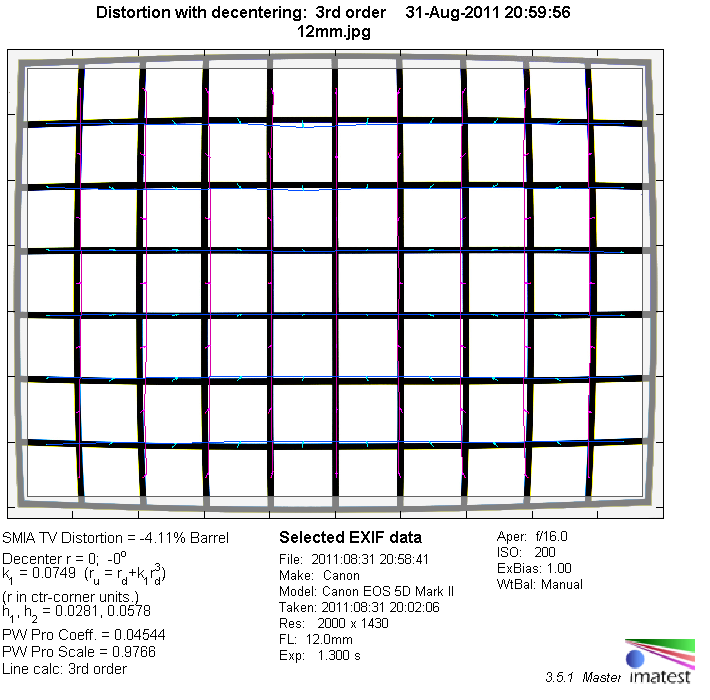|
Sigma AF 12-24mm f/4.5-5.6 HSM DG II - Review / Test Report - Analysis |
|
Lens Reviews -
Canon EOS (Full Format)
|
|
Page 2 of 3

Distortion
Ultra-wide lenses tend to produce quite a bit of barrel distortion and the Sigma doesn't break the rule here. At 12mm it shows a very heavy amount of barrel distortion (4.1%) which will be easily visible in scenes with straight artificial structures or e.g. a landscape scene with a flat horizon. The issues eases substantially to a moderate 1.6% at 17mm, and remember that this is actually the focal length where the zoom range of most ultra-wide zoom lenses is actually starting. At 24mm there's only a moderate degree of pincushion distortion (1.2%).
|
Move the mouse cursor over the focal length text marks below to observe the respective distortion
|
| 12mm |
17mm |
24mm |
|

|
Vignetting
Sigma emphasizes that the 12-24mm offers "superior peripheral brightness". While this is a valid statement to some degree it is only part of the story. Rectilinear wide angles lenses suffer (roughly) from the cos4 law of light falloff - this is also called "natural" vignetting. Keeping this in mind the vignetting may be interpreted as fairly moderate. That said, in absolute terms there's a heavy falloff of nearly 3 f-stops (EV) at 12mm at f/4.5. However, stopping down to f/8 results in a moderate vignetting of just over 1 f-stop (EV). The issue is, of course, reduced at 17mm and 24mm although it still helps to stop down a little.

MTF (resolution)
The interpretation of the Sigma's resolution characteristic is not easy. It is the only rectilinear zoom lens starting at 12mm so it is unclear what to expect due to the lack of references.
The center quality is nothing short of outstanding at 12mm and the border quality is also surprisingly high even at max. aperture. However, the corners are rather soft even at f/8. Regarding the high field curvature it is advisable to stop down to f/11 where the lens manages to deliver "good" albeit not great corners. The situation is much better at 17mm - the center quality remains highly impressive but the border AND corner quality is now also very decent - especially at f/8. Please note that the Sigma is basically as good as the Canon EF 16-35mm f/2.8 USM L II (and superior to the EF 17-40mm f/4 USM L) at 16mm and comparable aperture settings. The "long" end, thus 24mm is slightly softer in the image center and the borders/corners reach good quality here.
The centering quality of the tested sample was mediocre. The corner portion on the lower right side was softer than its left side counterpart (which was taken as a reference for the charts below).
Please note that the MTF results are not directly comparable across the different systems!
Below is a simplified summary of the formal findings. The chart shows line widths per picture height (LW/PH) which can be taken as a measure for sharpness.
If you want to know more about the MTF50 figures you may check out the corresponding Imatest Explanations
Field Curvature
As mentioned in the previous chapter, the Sigma suffers from high field curvature at 12mm. With a little experience it is possible to overcome most effects (out-of-focus corners) of the issue by setting the focus point towards the hyper-focal distance - the focus distance where you exploit the provided depth-of-field to the optimum.
However, in order to illustrate the amount field curvature we've prepared the following MTF graph. Usually we follow the focus field across the image field for measuring the point of the maximum local resolution. This is the industry-standard approach and fine for all lenses with an up to moderate field curvature. The chart below assumes a "flat wall" scenario where the center is set to the optimum focus distance - imaging that you stay in front of a flat building and simply use the camera's AF. As you can conclude the border/corner is much softer at large aperture settings and, as already mentioned, it makes sense to stop down to f/11 to equalize most of the field curvature.
Please note that this is the first review where we've presented a representation for the field curvature. We'll provide the figure from now on whenever appropriate. The absence of it in older reviews does not mean that these lenses have no field curvature issue - please refer to the review text in this case. We have mentioned field curvature issue in the past already.
Chromatic Aberrations (CAs)
Sigma is proud of its new FLD glass and we've seen some impressive results e.g. of the APS-C format Sigma 8-16mm f/4.5-5.6 DC here. The lateral CAs aren't quite as well controlled in the 12-24mm II but it remains still comparatively moderate (for an ultra-wide lens) with an average CA pixel width of about 2px at the image border at 12mm. Expect more than that in the image extreme corners though. The issues is reduced to about 1.3px at 17mm and just 0.5px at 24m which is hardly objectionable anymore.

|